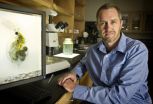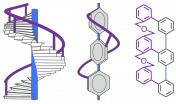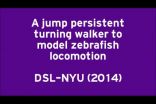INFORMATION:
Also working on this research were Jing Yang, postdoctoral fellow, psychology; Kathleen Marie Gates, postdoctoral fellow, human development and family studies; Peter Molenaar, Distinguished Professor of Human Development and Family Studies; Jennifer Legault, graduate student, neuroscience; and Kaitlyn A. Litcofsky, graduate student, psychology. Yang and Gates both held postdoctoral positions while conducting this research. Yang is now associate professor of applied linguistics, Guangdong University of Foreign Studies, China. Gates is now assistant professor of psychology, University of North Carolina at Chapel Hill.
The National Science Foundation supported this research.
Learning languages is a workout for brains, both young and old
2014-11-12
(Press-News.org) Learning a new language changes your brain network both structurally and functionally, according to Penn State researchers.
"Learning and practicing something, for instance a second language, strengthens the brain," said Ping Li, professor of psychology, linguistics and information sciences and technology. "Like physical exercise, the more you use specific areas of your brain, the more it grows and gets stronger."
Li and colleagues studied 39 native English speakers' brains over a six-week period as half of the participants learned Chinese vocabulary. Of the subjects learning the new vocabulary, those who were more successful in attaining the information showed a more connected brain network than both the less successful participants and those who did not learn the new vocabulary.
The researchers also found that the participants who were successful learners had a more connected network than the other participants even before learning took place. A better-integrated brain network is more flexible and efficient, making the task of learning a new language easier. Li and colleagues report their results in a recent article published in the Journal of Neurolinguistics.
The efficiency of brain networks was defined by the researchers in terms of the strength and direction of connections, or edges, between brain regions of interest, or nodes. The stronger the edges going from one node to the next, the faster the nodes can work together, and the more efficient the network.
Participants each underwent two fMRI scans -- one before the experiment began and one after -- in order for the researchers to track neural changes. At the end of the study period, the researchers found that the brains of the successful learners had undergone functional changes -- the brain network was better integrated.
Such changes, Li and colleagues suggested while reviewing a number of related studies, are consistent with anatomical changes that can occur in the brain as a result of learning a second language, no matter the age of the learner, as they reported in a recent issue of Cortex.
"A very interesting finding is that, contrary to previous studies, the brain is much more plastic than we thought," said Li, also co-chair of the interdisciplinary graduate degree program in neuroscience. "We can still see anatomical changes in the brain [in the elderly], which is very encouraging news for aging. And learning a new language can help lead to more graceful aging."
Meanwhile, Li and colleagues have begun working on interactive ways to teach language using virtual 3-D-like environments with situation-based learning to help the brain make some of those new connections more effectively. Such studies hold the promise that the process of learning a second language as an adult can in fact lead to both behavioral and physical changes that may approximate the patterns of learning a language as a child.
ELSE PRESS RELEASES FROM THIS DATE:
Rice University program models more detailed evolutionary networks from genetic data
2014-11-12
The tree has been an effective model of evolution for 150 years, but a Rice University computer scientist believes it's far too simple to illustrate the breadth of current knowledge.
Rice researcher Luay Nakhleh and his group have developed PhyloNet, an open-source software package that accounts for horizontal as well as vertical inheritance of genetic material among genomes. His "maximum likelihood" method, detailed this month in the Proceedings of the National Academy of Sciences, allows PhyloNet to infer network models that better describe the evolution of certain ...
Mental health providers not well prepared to care for military veterans, study finds
2014-11-12
Most community-based mental health providers are not well prepared to take care of the special needs of military veterans and their families, according to a new study by the RAND Corporation that was commissioned by United Health Foundation in collaboration with the Military Officers Association of America.
The exploratory report, based on a survey of mental health providers nationally, found few community-based providers met criteria for military cultural competency or used evidence-based approaches to treat problems commonly seen among veterans.
"Our findings suggest ...
UT Arlington team says non-genetic changes can help parents or offspring, not both
2014-11-12
A new study from The University of Texas at Arlington biologists examining non-genetic changes in water flea development suggests something human parents have known for years - ensuring a future generations' success often means sacrifice.
Matthew Walsh, an assistant professor of biology, and his team looked at a phenomenon called "phenotypic plasticity" in the Daphnia abigua, or water flea. Phenotypic plasticity is when an organism changes its trait expressions or physical characteristics, or those of its offspring, because of external factors. In Daphnia, that can mean ...
A twisted world -- chemists build a molecular banister
2014-11-12
Chemists at the University of Basel in Switzerland have succeeded in twisting a molecule by combining molecular strands of differing lengths. The longer strand winds around a central axis like a staircase banister, creating a helical structure that exhibits special physical properties. The results were published in the renowned scientific journal Angewandte Chemie International Edition.
The chemistry of all substances is to a large extent defined by their spatial arrangement. Many molecules can be present in two forms (enantiomers), which behave like a person's right ...
In preschoolers, office test overestimates eye's ability to change focus, reports Optometry and Vision Science
2014-11-12
November 12, 2014 - In preschool-aged children, a simple test performed in the ophthalmologist's or optometrist's office greatly overestimates the eye's ability to "flex and focus" in order to see small objects clearly, reports a study in the November issue of END ...
Regulatory and scientific complexity of generic nanodrugs could delay savings for patients
2014-11-12
Nanomedicine is offering patients a growing arsenal of therapeutic drugs for a variety of diseases but often at a cost of thousands of dollars a month. Generics could substantially reduce the price tag for patients -- if only there were a well-defined way to make and regulate them. An article in Chemical & Engineering News (C&EN), the weekly newsmagazine of the American Chemical Society, details the challenges on the road to generic nanodrugs.
Matt Davenport, a C&EN contributing editor, points out that in small-molecule therapeutics -- aspirin, for example -- the active ...
Artificial retina could someday help restore vision
2014-11-12
The loss of eyesight, often caused by retinal degeneration, is a life-altering health issue for many people, especially as they age. But a new development toward a prosthetic retina could help counter conditions that result from problems with this crucial part of the eye. Scientists published their research on a new device, which they tested on tissue from laboratory animals, in the ACS journal Nano Letters.
Yael Hanein and colleagues point out that a growing range of medical devices has become available to treat conditions, including visual impairment, that involve sending ...
Moderate consumption of sugary drinks has little impact on adolescents' metabolic health
2014-11-12
COLUMBIA, MO. - Sugar-sweetened beverages are the largest source of added sugar in the diets of adolescents in the United States, and young adults ages 15-20 consume more of these drinks than any other age group, according to the Centers for Disease Control and Prevention. Adolescent obesity rates, which have quadrupled over the past thirty years, led to widespread scrutiny of added dietary sugars, especially those found in carbonated beverages. Now, MU researchers have found that short-term, moderate consumption of high-fructose and high-glucose beverages has little impact ...
IU-led research team identifies genetic variant linked to better memory performance
2014-11-12
INDIANAPOLIS -- People with a newly identified genetic variant perform better on certain types of memory tests, a discovery that may point the way to new treatments for the memory impairments caused by Alzheimer's disease or other age-associated conditions.
In what the international research team is calling the largest study to date of human memory, an analysis of genomic data and memory test results from more than 14,000 older adults identified a location in the genome that was associated with better memory performance. The researchers noted that the gene has not been ...
Stock market models help NYU researchers predict animal behavior
2014-11-12
VIDEO:
Modeling used to forecast fluctuations in the stock market has been discovered to predict aspects of animal behavior. The movement of zebrafish when mapped is very similar to the stochastic...
Click here for more information.
In an unexpected mashup of financial and mechanical engineering, researchers have discovered that the same modeling used to forecast fluctuations in the stock market can be used to predict aspects of animal behavior. Their work proposes an unprecedented ...




